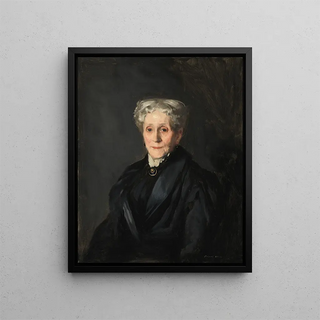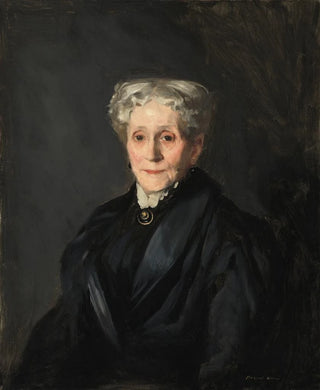Art print | Elizabeth Virginia Lanning Bradner Smith Mme George Cotton Smith - Robert Henri


View from behind

Frame (optional)
Elizabeth Virginia Lanning Bradner Smith art print by Robert Henri is a masterpiece that transcends mere portraiture to become a true exploration of identity and personality. Captured with remarkable finesse, this piece evokes not only the beauty of the subject but also the spirit of the era in which it was created. Henri, a prominent figure of the American realist movement, manages to seize the very essence of his model, transforming a frozen moment into a vibrant emotional experience. The way he plays with light and shadow, as well as the nuances of color, makes this portrait a genuine testament to the artistic sensitivity of the early 20th century.
Style and uniqueness of the art print
Robert Henri's style is characterized by a bold approach and an impressionist technique that brings his subjects to life. In the portrait of Elizabeth Virginia Lanning Bradner Smith, one can observe a masterful use of warm colors and expressive brushstrokes that infuse a unique dynamism into the composition. Henri does not merely reproduce his model's face; he captures their soul, creating an intimate connection between the art print and the viewer. The meticulous details, from sparkling eyes to textured clothing, testify to his skill in rendering every aspect of the subject with striking precision. This art print stands out for its ability to evoke an atmosphere of confidence and serenity, inviting the viewer to linger on the subtleties of human expression.
The artist and his influence
Robert Henri, born in 1865, is one of the founders of the Ashcan School movement, which advocated for a realistic representation of urban life. His portraits, including that of Elizabeth Virginia Lanning Bradner Smith, are emblematic of this desire to capture the truth of human beings in their daily lives. Henri established himself as an innovator, breaking away from the academic conventions of his time to embrace a more authentic vision of art. His influence extends beyond his own work, inspiring many contemporary and future artists to explore the complexity of the human condition through portraiture. Emphasizing individuality and personal expression

Matte finish

View from behind

Frame (optional)
Elizabeth Virginia Lanning Bradner Smith art print by Robert Henri is a masterpiece that transcends mere portraiture to become a true exploration of identity and personality. Captured with remarkable finesse, this piece evokes not only the beauty of the subject but also the spirit of the era in which it was created. Henri, a prominent figure of the American realist movement, manages to seize the very essence of his model, transforming a frozen moment into a vibrant emotional experience. The way he plays with light and shadow, as well as the nuances of color, makes this portrait a genuine testament to the artistic sensitivity of the early 20th century.
Style and uniqueness of the art print
Robert Henri's style is characterized by a bold approach and an impressionist technique that brings his subjects to life. In the portrait of Elizabeth Virginia Lanning Bradner Smith, one can observe a masterful use of warm colors and expressive brushstrokes that infuse a unique dynamism into the composition. Henri does not merely reproduce his model's face; he captures their soul, creating an intimate connection between the art print and the viewer. The meticulous details, from sparkling eyes to textured clothing, testify to his skill in rendering every aspect of the subject with striking precision. This art print stands out for its ability to evoke an atmosphere of confidence and serenity, inviting the viewer to linger on the subtleties of human expression.
The artist and his influence
Robert Henri, born in 1865, is one of the founders of the Ashcan School movement, which advocated for a realistic representation of urban life. His portraits, including that of Elizabeth Virginia Lanning Bradner Smith, are emblematic of this desire to capture the truth of human beings in their daily lives. Henri established himself as an innovator, breaking away from the academic conventions of his time to embrace a more authentic vision of art. His influence extends beyond his own work, inspiring many contemporary and future artists to explore the complexity of the human condition through portraiture. Emphasizing individuality and personal expression






